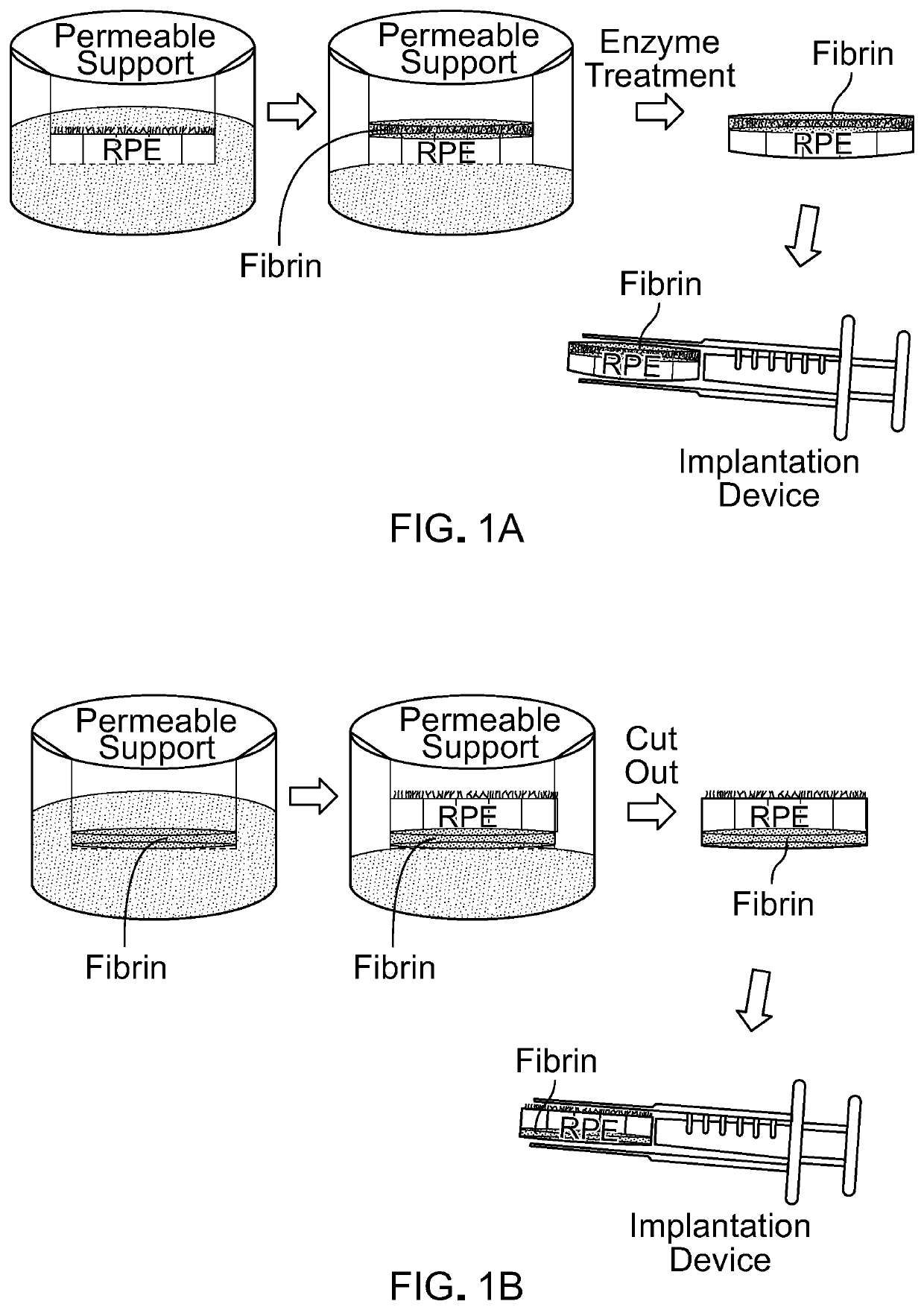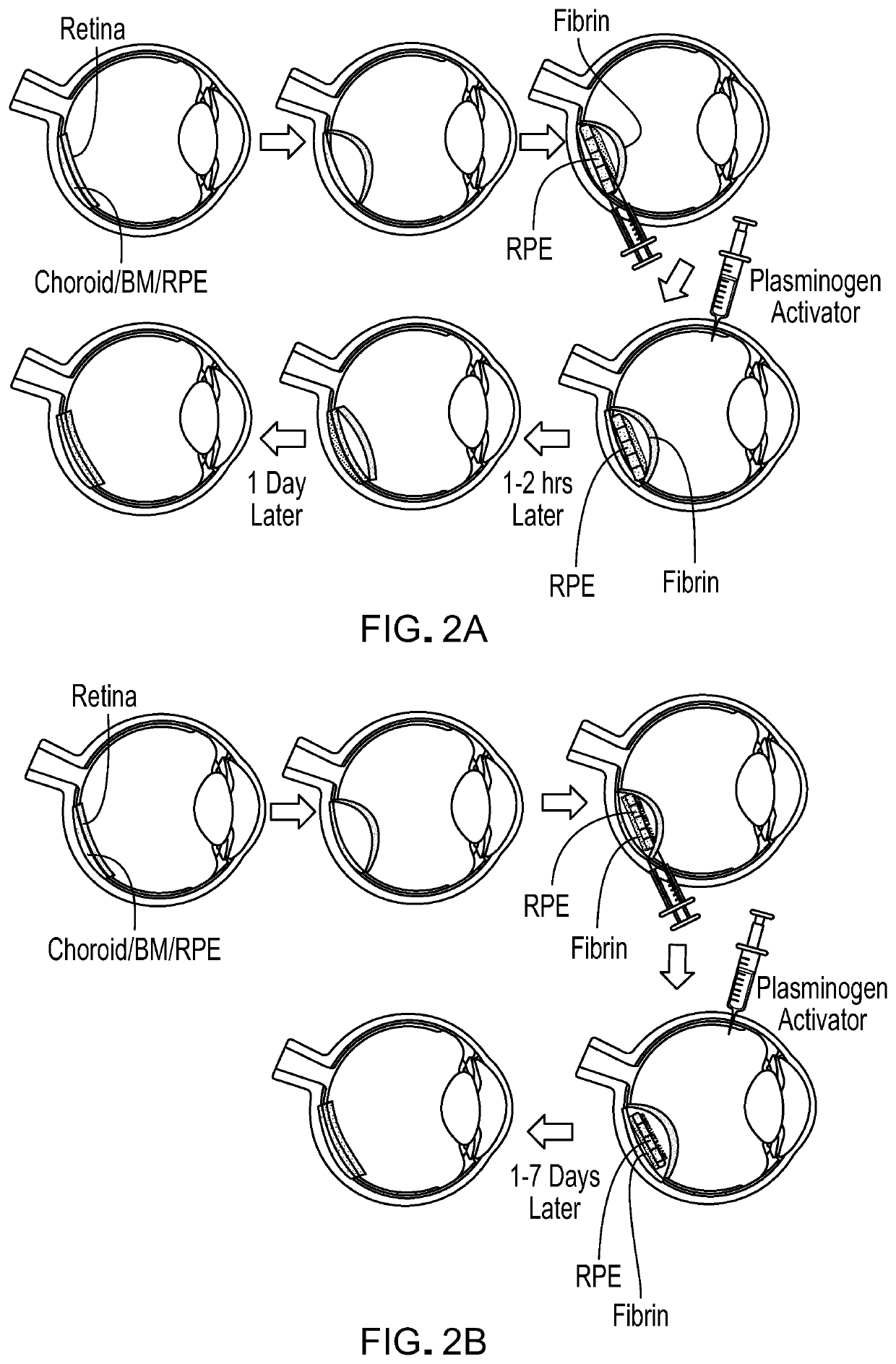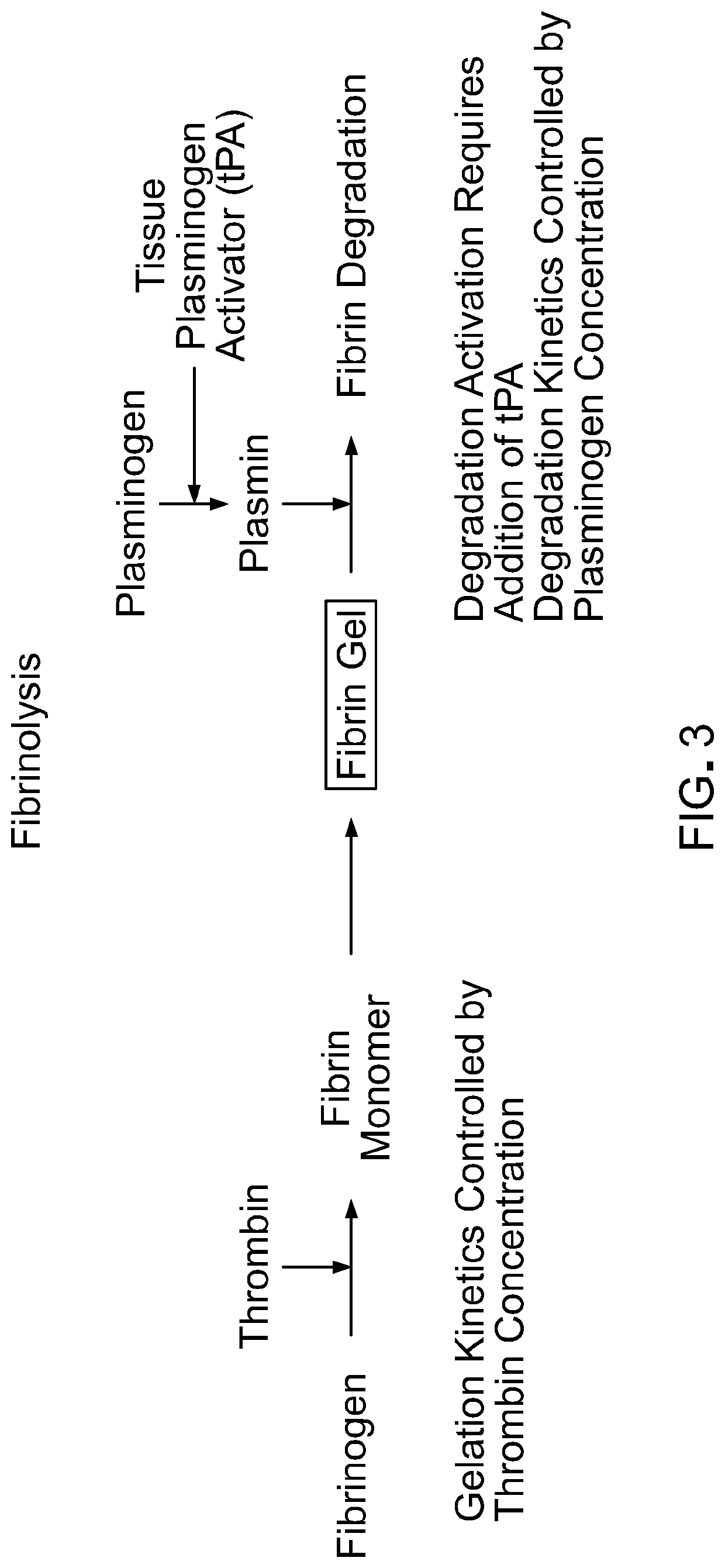Methods and materials for using fibrin supports for retinal pigment epithelium transplantation
a fibrin support and pigment epithelium technology, applied in the direction of prosthesis, drug composition, peptide/protein ingredient, etc., can solve the problems of rpe dysfunction, eventual photoreceptor death, many difficulties in translation to clinical application,
- Summary
- Abstract
- Description
- Claims
- Application Information
AI Technical Summary
Benefits of technology
Problems solved by technology
Method used
Image
Examples
example 1
brin Hydrogels for IPSC-RPE Transplantation
Chemicals
[0087]Fibrinogen was obtained from three sources: as Evicel from Ethicon (60 mg / mL), as Tisseel from Baxter (95 mg / mL), and as research grade material from Sigma-Aldrich (57 mg / mL). Thrombin also was obtained from three sources: part of Evicel from Ethicon, part of Tisseel from Baxter, and research grade material from Sigma-Aldrich. Plasminogen was obtained as research grade material from Sigma-Aldrich. Recombinant tissue plasminogen activator (tPA) was obtained as research grade material from Sigma-Aldrich.
Cells
[0088]IPSC-RPE cells were produced as described elsewhere with modification (Johnson et al., Investig. Ophthalmol. Vis. Sci., 56:4619 (2015)). A membrane support was utilized with apical and basal media, including either transwell or HA membrane. The membrane surface was coated with a collagen gel, per manufacturer's protocol, and, either subsequently or alternatively, coated with a geltrex or matrigel solution, up to 0.1 m...
example 2
f Aprotinin on Fibrin Attachment and Cell Viability
[0113]Studies were conducted to determine the effect of Aprotinin on fibrin gel attachment and maintenance, and on cell viability. iPSC-RPE cells were cultured for two weeks on a fibrin gel with (FIG. 14A) and without (FIG. 14B) geltrex coating, in media containing 50 U / mL Aprotinin. The inclusion of Aprotinin in the media appeared to prevent fibrin gel degradation. In addition, these studies indicated that attachment of the cells to the fibrin gel may occur independent of the presence of geltrex. The cells remained adherent after the gel was released from the plates (FIG. 15A), and there was minimal cell removal after the gel was cut (FIG. 15B).
[0114]To assess the viability of iPSC-RPE cells in fibrin gel after culture with Aprotinin for two weeks, followed by detachment and cutting of the gel, cells were stained with calcein-AM (Live) and ethidium homodimer (Dead). The cells remained viable after detachment and cutting, whether ge...
example 3
for Retinal Pigment Epithelium Monolayer with Apical Fibrin
[0116]1) Gel 2.5 mg / mL collagen onto cellulose ester membrane filter insert.[0117]a. 1.0-5.0 mg / mL collagen.[0118]b. Cellulose ester, polycarbonate, PTFE, TCPS membrane filter.[0119]2) Coat the collagen surface with 1:5 dilution of matrigel.[0120]a. Range: 1:1-1:50 dilution.[0121]b. Matrigel, geltrex or purified laminin.[0122]3) Plate cells at 0.5×106 cells / cm2.[0123]a. 0.1-2.0×106 cells / cm2.[0124]4) Culture for about 2 weeks.[0125]a. 1-6 weeks.[0126]5) Wash cells with PBS.[0127]6) Dry cell surface.[0128]7) Spray 80 μL of mixed 50 mg / mL fibrinogen, 2 U / mL plasminogen, and 100 U / mL thrombin, at total flow rate of 80 uL / sec, 0.8 bar for 1 second at a height of 10 cm.[0129]a. Spray 30-200 μL of mix.[0130]b. 30-70 mg / mL fibrinogen.[0131]c. 0.1-4.0 U / mL plasminogen.[0132]d. 10-600 U / mL thrombin.[0133]e. 30-400 μL / seconds flow rate.[0134]f. 0.6-1.2 bar.[0135]g. 5-15 cm height.[0136]8) Allow fibrinogen to gel 1 hour 37° C.[0137]a. ...
PUM
| Property | Measurement | Unit |
|---|---|---|
| Thickness | aaaaa | aaaaa |
| Thickness | aaaaa | aaaaa |
| Mass | aaaaa | aaaaa |
Abstract
Description
Claims
Application Information
 Login to View More
Login to View More - R&D
- Intellectual Property
- Life Sciences
- Materials
- Tech Scout
- Unparalleled Data Quality
- Higher Quality Content
- 60% Fewer Hallucinations
Browse by: Latest US Patents, China's latest patents, Technical Efficacy Thesaurus, Application Domain, Technology Topic, Popular Technical Reports.
© 2025 PatSnap. All rights reserved.Legal|Privacy policy|Modern Slavery Act Transparency Statement|Sitemap|About US| Contact US: help@patsnap.com



